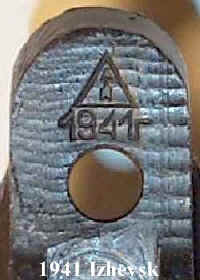
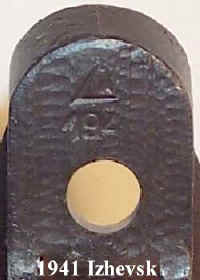
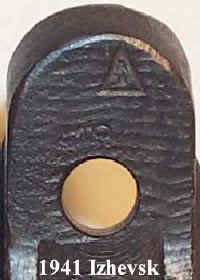
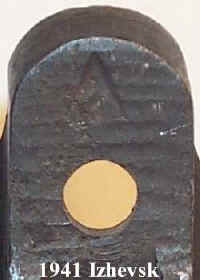
| Mosin Nagant Theories, Opinions, and Observations All content copyright © 7.62x54r.net |
This page consists of a series of brief articles explaining various aspects of Mosin Nagant history and collecting. Not all of the articles are necessarily based on "hard facts", some are subject to interpretation, and some collectors may not agree with the conclusions presented here. The opinions and ideas expressed are solely those of the author and further research on the part of the reader is encouraged. Evidence will be presented to support the conclusions whenever possible.
Articles on separate pages:
Mosin Nagant Rifle Receiver Variations A reference on the progression of changes made to the receiver over time
Mosin Nagant Rifle Barrel Contours A comparison of barrel dimensions of different models
Mosin Nagant Rifle Soviet Stock Feature Relationships A guide to the relationship between various models and stock features
Mosin Nagant MO Marks Pictures, data and information on this mark with a sortable data table
Soviet Mosin Nagants Built on Earlier Receivers Several examples from 1919 to 1945 and theories behind them
New England Westinghouse Barrel Marks Examples of numerous variations of logos on these M91s
Mosin Nagant Import Marks Pictures and information on import marks by various companies over the years
Articles on this page:
Why is Tula Preferred Over Izhevsk?
Partial and Missing Tang Dates on 1941 and 1942 Izhevsk Receivers
Finnish, Finned, Finn Marked, Finn Captured, and Finn Purchased Mosin Nagants
Hexagonal or Octagonal Receiver?
Ex-Dragoon or Prototype M91/30?
Wreath with Hammer and Sickle, Arsenal Mark or Country Mark?
Changes in Mosin Nagant Markings as They Relate to Politics
Bolt Open or Closed?
It is often asked whether it is preferable to store Mosin Nagants with the bolt in the open or closed position. While there is not necessarily a "right" or "wrong" way, the open position is generally favored. This usually brings up another question concerning the advisability of leaving the main spring under constant tension. Any potential harm to the spring is debatable, but the solution is simple. With the bolt open, the cocking knob can be pulled to the rear until the sear lug is withdrawn from the slot in the bolt connector bar and then turned 90 degrees counterclockwise. This relieves the compression on the spring and also prevents the bolt from being closed. The bolt may be removed and reinserted in the normal manner while in this decocked state. There are several advantages to leaving the bolt in this position besides the aforementioned relief of the main spring. 1) With the bolt open there is no pressure on the interrupter/ejector spring. 2) It is apparent at a glance that the rifle is unloaded and safe to handle. 3) Air can circulate through the bore minimizing any chance for moisture to accumulate. 4) Rifles can be stored more compactly with the short straight handle parallel rather than perpendicular to the action. From a collector's standpoint leaving the bolt open and decocked is also "historically accurate" as this is how the official Soviet Mosin Nagant manual instructs soldiers to store them while in barracks.
Why is Tula Preferred Over Izhevsk?
A common question, especially among newer Mosin Nagant collectors, is why Tula rifles seem to be preferred, and even command a premium price, over Izhevsk rifles. With any collectible, whether a firearm or not, scarcity is a driving force of desirability. In recent years the majority of Mosin Nagants imported from the former Soviet Union have been M91/30s, including updated Dragoons, M38s and M44s. Tula M38s and Tula M44s are certainly much scarcer than Izhevsk carbines and the preference is obvious in these cases. With the M91/30s though, the total production at Tula is outnumbered by the 1942 and 1943 Izhevsk production alone. When production numbers for all years are considered, only one in three M91/30s is a Tula. While pre-WWII Tula rifles are actually more common than pre-WWII Izhevsk rifles, this fact is often lost in the sea of WWII Izhevsk rifles on the US collector's market.
Another factor is pure aesthetics. Few will argue that in general Tula had more interesting barrel markings and logos over the years which, combined with frequent changes in style, can make collecting Tula rifles more interesting. Of the two post-1928 marks found on the recently imported rifles the bold Tula star is often seen as more impressive than the relatively small Izhevsk triangle and recalls one of the primary symbols of "the Evil Empire" of the Cold War. Izhevsk is also known for it's rough machining during WWII while Tula maintained a constant high degree of workmanship throughout production. Regardless of outward appearances, Izhevsk rifles are just as well made when it comes to function, accuracy and general suitability for the intended purpose. Mosin Nagants were built to win wars and not to please the eye.
The fact that Tula is easier to spell and pronounce is often mentioned among collectors, but the validity of this reasoning is questionable. The Tula association with Tsar Peter the Great is another factor and even the Bolsheviks acknowledged Tula as the "premier" or "foremost" arsenal as evident by the wording of the barrel marks during the 1920s. Some regard any premiums for Tula rifles as simply a marketing ploy by distributors and dealers to increase profits. However, in the case of M38s and M44s this is justified due to the low production numbers.
The apparent general preference for Tula is likely a combination of these reasons and it is ultimately up to the individual collector to decide for themselves whether to focus on Tula rifles or not. There are almost as many reasons why Izhevsk should be preferred as the opposite and the debate will likely continue as long as Mosin Nagants are collected.
Partial and Missing Tang Dates on 1941 and 1942 Izhevsk Receivers
The majority of Mosin Nagants have the arsenal mark and date on the bottom of the receiver tang with some exceptions in M91 production. However, there was a period early in WWII when Izhevsk did not fully mark the tangs. Some time in 1941 the last digit was dropped from the date. This would typically be attributed to careless workmanship since it's not uncommon to find poorly struck marks on Mosin Nagants. However, it's been well documented on several rifles with a distinct "194" below the arsenal mark. There are also rifles with only "19" which are also dated 1941 on the barrel or have a receiver that fits the 1941 production pattern. The reason for these partial dates isn't fully understood, but there is speculation that the intention was to complete the date later. There are also 1941 Izhevsk rifles with a clear arsenal mark and no date whatsoever on the tang. This pattern continues into 1942 with clear arsenal marks and no date well documented in that year also. At least one rifle with a 1942 Izhevsk barrel has been documented that has no date or arsenal mark on the tang. There are 1942 Izhevsk receivers with the arsenal mark and a full date, but they seem to be less common than the undated ones. Although Mosin Nagant production doesn't always follow logical patterns, it does seem that the date was slowly dropped from the tang in 1941 and then all markings dropped in 1942 before the complete markings reappeared before the end of the year. During this period the Soviets were under extreme pressure from the Germans and everything possible was being done to expedite arms production. The correlation between this and the tang marks at Izhevsk seems evident, although not completely understood. Thanks to USMCsean and DudleyDR of Gunboards.com for corroboration in identifying this pattern.
 |
 |
 |
 |
| Arsenal mark and complete date | Arsenal mark and partial date "194" | Arsenal mark and partial date "19" | Arsenal mark and no date |
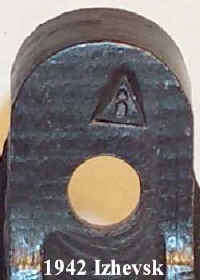 |
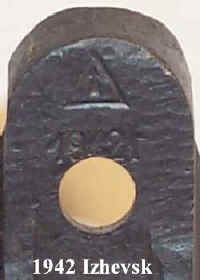 |
|
| Arsenal mark and no date | No arsenal mark or date | Arsenal mark and complete date |
Czech M91/38, or M91/44?
The M91/38 carbine is an interesting Cold War variation of the Mosin Nagant which was made by cutting down M91 rifles. Little is know about their history other than the fact that the conversion was done in Czechoslovakia as evidenced by Czech arsenal marks on the receiver and barrel. Their subsequent use, if any, by military or police forces remains a mystery. In addition there is evidence that the configuration in which they are now found by collectors was probably not the original intent when the work was done. The typical M91/38 carbine is cut down from a Russian made M91 rifle to an overall length of 40" which is the same as the M38 and M44 carbines. It most closely resembles the M38 as it does not have the attached bayonet of the M44 or any provision for one. However, there are signs that this was not always the case.
The M91/38 front sight base is attached to the barrel by way of a sleeve which is typical of the Soviet carbines. Rather than a short sleeve with a narrow sight base as found on the M38 and M91/59, the sleeve is relatively long and has a wide sight base just as the M44. It does not have the M44's bayonet lug, but upon close examination the remains of the bayonet lug pin can often be seen. It appears as a "figure eight" shape due to the round barrel where part of it has been machined away. Evidently the bayonet lug itself was also removed. The sight base itself is also slightly narrower than the M44 base but this appears to be from the same process that removed the bayonet lug.
Further indication that the M91/38 was intended to have an attached folding bayonet is found in the stock. While some M91/38s have M38 type stocks, the majority are in M44 type stocks with the bayonet groove along the right side. This may not seem significant because Soviet M38s are often found in M44 stocks due to concurrent production and later refurbishments. However many of the M91/38 stocks are cut down from M91 stocks which of course did not originally have a bayonet groove. Apparently the bayonet grooves were added to the M91 stocks at the time they were cut down for use on the carbines. There is proof that M91 stocks were cut down because some of them do not have the recoil cross bolt which was only omitted on the earliest M91 production stocks. Other M91/38 stocks appear to be new production in the late/post war style and also have the bayonet groove.
Circumstantial evidence comes from the former Yugoslavia where Cold War era 7.62x54r ammunition crates have a label which lists suitable weapons to use the cartridges with. Among the models listed are the M38, M44 with bayonet, and M44 without bayonet. Listing the M38 and the M44 without bayonet seems redundant, until one considers that there might have been M44s which had the bayonet removed and were considered a different model from the M38. Admittedly the connection is tenuous, but taken in combination with the other evidence it is certainly worth noting.
The previous evidence is admittedly speculative at best. However, in 2005 two carbines surfaced which further support the theory. They each have every indication of being an M91/38 with the Czech arsenal marks, hex receivers, M91 era barrel dates and markings, carbine type sights, and M44 stocks. The unique and telling difference is they each have an intact M44 style folding bayonet. These carbines were bought in retail stores which stock M44s for the same price as typical M44s, which is a good indication that they are not fakes built for profit. The import markings are of a recent type and apparently they had been stored with M44s in Eastern Europe before importation to the US as M44s. One remaining question is when the decision was made to remove the bayonets from the M91/38s. Was it before work was completed and they left the Czech arsenal, or were the carbines stored, or even issued for a time, before the bayonets were removed? In light of the two which became mixed with M44s it seems that at least some of the M91/38s were distributed for some time before being converted to their current configuration.
Without documentary evidence from the former Soviet Union or elsewhere within the Warsaw Pact the existence of the "M91/44" as an issue model of Mosin Nagant cannot be confirmed. The fact that it did exist, even if for a brief period, seems obvious though in light of the evidence presented here.
Long sight base sleeve with remains of bayonet lug pin |
Early M91 stock without recoil bolt and added bayonet groove |
Cut Down Mosin Nagants
While some Mosin Nagants did have the barrels cut down at various times to upgrade them to a newer model, or to create a new model, this was not typical until after WWII. The original M91 Infantry rifle has a 31.5" (including the threaded portion inside the receiver) barrel and these are still relatively common in spite of wartime losses over decades of combat service. Understandably some confusion results from the fact that the less common M91 Dragoon and M91 Cossack rifles were built at some of the same arsenals during some of the same years. They are also very similar with the primary difference being a shorter barrel at 28.75". However, M91 Infantry rifles were not cut down to create the M91 Dragoon and M91 Cossack rifles. They were intended for two different types of troops, infantry and mounted, and there was a need for both. While the shorter rifles did begin production a few years after the Infantry model and continued in production for several years after Infantry production ended, it was not considered an "improvement" as that term is typically understood.
The M91 Cossack was phased out relatively early but the M91 Dragoon evolved into the M91/30 rifle which became the standard infantry rifle. The barrels of the two models are the same length (28.75") and this reflected the worldwide tendency toward shorter rifles for infantry. While many Dragoon rifles were upgraded to M91/30 specifications this involved little more than replacing the front and rear sights. It did not require the barrel to be cut down because they were already the same length. M91 infantry rifles were not typically cut down and upgraded to M91/30 specifications. If an M91/30 is dated prior to 1926 when M91 Infantry rifle production ended then it most likely was once a Dragoon rifle. There are rare exceptions and the only way to know is if the rifle is from an arsenal that did not produce Dragoon rifles. For more information on the Dragoon upgrades see the Ex-Dragoon or Prototype M91/30? article below.
The next evolution of the Mosin Nagant rifle in the Soviet Union was the M38 carbine which has a barrel length of 20.25". These were produced concurrently with the M91/30 and were intended for rear echelon forces and those who didn't typically fight with a rifle, but needed one for defensive situations, such as artillerymen. M38 carbines were not cut down from M91/30s and certainly not M91 Infantry or Dragoon rifles. Virtually all M38 production was during WWII and if there were a shortage of carbines then Infantry rifles would have been issued in their place rather than wasting precious manpower cutting them down. In 1943 a need developed for a short handy carbine that accepted a bayonet for urban fighting as the Soviets forced the Germans to retreat. The M44 evolved from the M38 and is essentially the same but with an attached folding bayonet. These were new production and not cut down from earlier rifles either. Occasionally M44s, and even less commonly M38s, are found with older hexagonal style receivers which were not produced after 1936. In these cases the carbines were not cut down from the older rifles, but rather the older receiver was fitted with a new barrel and used to build a carbine. There are also M91/30s built in this manner with new barrels on older receivers.
During the Cold War Mosin Nagant rifles were cut down in two different operations. The first was done in Czechoslovakia where M91 rifles were shortened to carbine length with a 20.25" barrel. These are known as the M91/38 among US collectors and as the M91/44 in Europe. It is known that M91 Infantry and M91 Cossack rifles were used because there are examples from arsenals that only produced the Infantry rifle and others with the Cossack "Ka3" mark still on the barrel. It is assumed that Dragoon rifles were also cut down, but there is no way to be sure unless one surfaces that is dated after the end of M91 Infantry rifle production. It is also possible that some M91/30s were used in this project, but none have been verified. The M91/38 has the original M91 rear sight removed and it is replaced with a carbine rear sight of the same type as M38s and M44s. The front sight is mounted to a sleeve over the barrel that is made from an M44 front sight/bayonet lug sleeve with the bayonet lug turned off. These are easily identifiable by the older barrel markings and the Czech arsenal marks on the receiver and barrel.
The second instance where Mosin Nagants were shortened involved M91/30s but the location of the arsenal that performed the work is not known. The project was presumably done, or at least begun, in 1959 as the barrels have "1891/59" added to the typical marks. Because of this the model is known as the M91/59 among US collectors. The majority of the rifles used were M91/30s although M91/59s dated prior to 1930 are known. It is presumed that these were Dragoons that were upgraded to M91/30 specifications and later cut down. However, it's certainly possible that they went straight from Dragoon configuration to M91/59 configuration. The M91/59 is the same length as the M38 and M44 carbines with a 20.25" barrel and retains the longer M91/30 rear sight base and leaf with the graduations above 10 (1,000 meters) removed.
In summary, with the exception of M91/38s and M91/59s, Mosin Nagant rifles were not typically cut down to create other models. Many were upgraded and improved over the years, but shortening the barrel was not part of the process with rare exceptions.
Finnish, Finned, Finn Marked, Finn Captured, and Finn Purchased Mosin Nagants
These terms are often used interchangeably by collectors when in fact there are important, but subtle, differences in the meanings. Much of the confusion is due to the fact that all Mosin Nagants used by Finland originated in Russia or the Soviet Union either as a complete rifle or as a receiver. This includes M91s built in France and the United States under contract to Russia.
The term "Finnish, or Finn, Mosin Nagant" should be reserved for rifles built in Finland such as M27s, M28s, M28/30s, M39s, Tikka M91/30s, VKT/B/Tikka M91s, M24s, and P-Series, along with the rare carbine variations of some of these. The P-Series might be argued against by some because it still has the Russian barrel. However, because the visible Russian markings are completely obliterated and the work done relining the barrel is more extensive than the typical repairs, it qualifies as "Finnish".
"Finned" and "Finn marked" can be used almost interchangeably but even these terms have different meanings to a seasoned collector. A "Finned Mosin Nagant" is a Russian or Soviet built rifle, again including French and US produced M91s, which has been modified in Finland. This can include replacing parts such as sights, renumbering parts such as the bolt, refinishing, splicing, or replacing the stock, rebluing of the metal, or simply adding wire sling hangers. A "Finn marked Mosin Nagant" won't necessarily have any modifications done to it and will simply have an "[SA]" or other Finnish property or inspection mark applied to it. Of course most "Finned Mosin Nagants" will also be "Finn marked", but not in all cases.
The most mis-used term applied to Mosin Nagants associated with Finland is "Finn captured". There are certainly many Mosin Nagants that were captured by Finland at three distinct periods in history. The first being the declaration of Finnish Independence in 1917 when Russian troops stationed in Finland were ousted and large stocks of arms were retained. The second was the Winter War of 1939-1940 when large numbers of invading Soviet troops were killed or captured. The third period was the Continuation War of 1941-1944 when Finland fought to regain territory lost in the Winter War. This conflict evolved into relatively stagnant trench warfare and the numbers of captured rifles were not as great as during the shorter more mobile Winter War. Any Mosin Nagant acquired during these conflicts is certainly "Finn captured" but Finland also acquired many Mosin Nagants in other ways. This was primarily from the late 1920s through the 1930s by purchase and trade with various countries around the world.
During World War I Russia lost many rifles to various countries and had sold or given others as military aid. Between the First and Second World War most countries attempted to standardize and upgrade their arms. Finland took advantage of this by trading non-Mosin Nagant rifles for Mosin Nagants and purchasing others outright. This was handled by Oy Transbaltic Ab, a Finnish company established expressly for this purpose. For more detailed information on captured and purchased Mosin Nagants from this era see the Mosin-Nagants of Imperial Russia article at the Jaeger Platoon website. Germany also sold Mosin Nagant rifles to Finland in 1944 and undoubtedly many of these were relatively new production that had been recently captured on the Eastern Front. Because Mosin Nagants from the beginning of production to as late as the end of the Russian Civil War in 1922, along with possibly later rifles purchased from Germany, were both captured (during the WWII era) and purchased by Finland it is impossible to say with certainty that a specific rifle is "Finn captured". However, collectors are generally reluctant to refer to one as "Finn purchased" and often mis-apply the term "capture". Mosin Nagants associated with Finland from the Soviet era after 1922 can generally be assumed to have been captured during the Winter or Continuation Wars although there is the small chance that they were from the German purchase. The term "Finn capture" is generally considered proper for these although they might be in fact "German capture" rifles. Of course many of these are also "Finned" or "Finn marked". Thanks to "Alko" of Gunboards.com for the information on the late purchase from Germany.
Summary of terms applied to Mosin Nagants associated with Finland |
||
| Term | Definition | Models |
| Finnish | Rifles built with Finnish barrels or with barrels relined and remarked by Finland | M24, P-Series, M27, M28, M28/30, M39, Tikka M91/30, VKT/B/Tikka M91 |
| Finned | Rifles made in other countries with Finnish modifications | M91, M91 Dragoon, M91/30, M38, M44 (carbines are uncommon and generally unmodified although M44s sometimes had the bayonet removed) |
| Finn marked | Rifles made in other countries with Finnish marks applied | M91, M91 Dragoon, M91/30, M38, M44 (carbines are uncommon) |
| Finn captured | Rifles made in other countries and captured during conflict by Finland | Possibly 1922 and earlier M91 and M91 Dragoon; More likely, but not certainly, 1923 and later M91 Dragoon, M91/30, M38, M44 |
| Finn purchased | Rifles made in other countries and purchased or traded for by Finland | Possibly 1922 and earlier M91 and M91 Dragoon; Less likely, but possibly, 1923 and later M91 Dragoon, M91/30, M38, M44 |
| Finn associated | Any rifle used by Finland encompassing all of the above categories | Any of the above |
| Notes: "Other countries" refers to Russia and the Soviet Union and M91s made under contract to Russia in France and the United States. "Finn purchased" and "Finn associated" are not terms generally in use by Mosin Nagant collectors. |
||
Hexagonal or Octagonal Receiver?
In 1935 the Soviet Union changed the Mosin Nagant receiver to a round pattern to simplify the manufacturing process. The earlier receivers are commonly known as hexagonal or "hex" receivers among collectors, but the term is certainly debatable. Some prefer "octagonal" arguing that this is a more accurate description of the actual shape of the receiver. In fact neither term is correct as the receiver is an irregular shape with characteristics of a hexagon, octagon, and circle as shown in the drawings below.
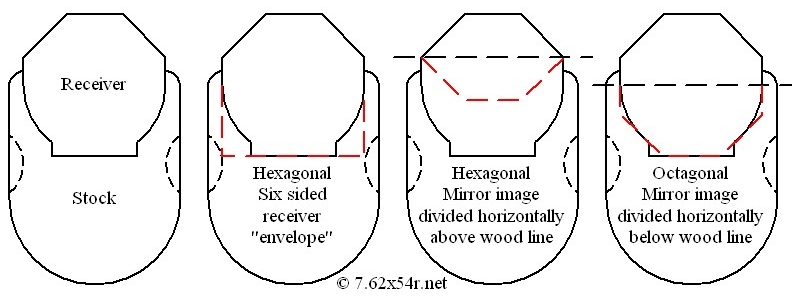
As the later receivers are known by the term "round", as opposed to "circular", the more fitting term for the earlier receivers is probably "angular" as opposed to either hexagonal or octagonal. However, "hex" has come into common usage among the majority of Mosin Nagant collectors in the United States and because of it's comparative simplicity and ease of pronunciation is most likely going to remain the accepted term in the future. For more information on receiver changes see the Mosin Nagant Rifle Receiver Variations page.
Ex-Dragoon or Prototype M91/30?
There seems to be much confusion among collectors between these two variations of Mosin Nagants and also the M91 Infantry rifle. This is due to the concurrent production of the M91 Dragoon rifle and the M91/30 from 1927 to 1932 and the fact that many Dragoon rifles were upgraded to M91/30 specifications. Unscrupulous or ignorant dealers have contributed to the problem by improperly describing rifles as "rare M91/30 prototypes".
The first step in clearing this up is to define the differences between the M91 Infantry and M91 Dragoon rifles, thus removing the M91 Infantry rifle from the equation. The M91 Infantry rifle was produced from 1892 to 1926 and has a 31.5" barrel and 51.5" overall length. The M91 Dragoon, and less common Cossack, rifle was produced from 1893 to 1932 and has a 28.75" barrel and 48.5" overall length. It was issued to mounted troops who needed a shorter, handier rifle. Other than minor differences in the sling attachment and handguards the two versions are essentially identical except in length. M91 Infantry rifles were not typically shortened to Dragoon length or upgraded to M91/30 specifications. This would have involved cutting down the barrel and most were left somewhat original. There are exceptions but they are rare. The only way to be certain that a rifle is an upgraded M91 is if it were from an arsenal that did not produce Dragoons or from a year that Dragoons were not produced. There was an upgrade program for M91s after the adoption of the spitzer bullet in 1908 but all this involved was changing the rear sight leaf and adding the recoil bolt to the stock. The sling slots were also cut in and the sling swivels removed, but this was later and unrelated to the bullet change. M91s without these upgrades are extremely rare. None of these upgrades have any relationship to later Dragoon upgrades, but are mentioned to clarify that the term "upgraded M91" is valid and in fact a common variation of Mosin Nagant.
In 1927 changes were made to the Dragoon rifle (Cossack rifle production ended by 1920) and it began to evolve into the M91/30. These rifles were the true "prototype M91/30s" but the Dragoons were still produced in much greater quantities until 1930. The M91/30 was officially adopted at this time and became the focus of production. However, the Dragoon was still produced in lesser numbers through 1932. The two rifles are very similar having the same length barrel and overall length. The primary difference is the sights with the Dragoon having the same type as the M91 Infantry rifle and the M91/30 having a flat rear leaf and globe protected front post. In fact the M91/30 globe protected front post was not fully evolved until around 1932 with a taller version of the M91 blade being used until then.
Dragoons were upgraded to M91/30 specifications on a limited scale prior to WWII and on a massive scale after WWII. Because of the extensive refurbishment of practically all Mosin Nagants in the Soviet Union after WWII there is no way to be certain if a 1927 to 1932 rifle is an upgraded Dragoon or an original M91/30. However, odds are that the pre-1930 rifles are upgraded Dragoons, also known as ex-Dragoons, since they were the majority of production during that time. Conversely, odds are that 1930 and later rifles were originally built as M91/30s and are not upgraded Dragoons. Therefore any rifle made prior 1927 is certainly an ex-Dragoon and any rifle made after 1932 is certainly an original M91/30. This leaves the distinct possibility that a 1927 to 1929 dated rifle in M91/30 configuration is in fact a "prototype M91/30". As previously stated, the odds are against this and it should be considered unscrupulous, if not outright fraudulent, to describe a rifle in this manner. On the other hand, any rifle dated 1930 or later and in M91/30 configuration is certainly an M91/30 now regardless of whether it was originally built as one or as a Dragoon.
It should be mentioned that barrel markings were changed at various times but at no time had any relationship to changes in models or configurations. The same marks were used on different models being produced at the same time and cannot be used to determine the original configuration of a rifle.
Wreath with Hammer and Sickle, Arsenal Mark or Country Mark?
A mark that is familiar to even those with only a passing interest in Mosin Nagants is the "wreath with hammer and sickle". A common, yet incorrect, name for this mark is "the Izhevsk crest". This is certainly understandable as the mark was used on Izhevsk rifles from the 1920s until the end of Mosin Nagant production in 1948. I appeared on the top receiver flat just behind the barrel only in the mid 1920s and at the top of the barrel shank for it's entire use. During this time the Izhevsk arsenal mark, a bow and arrow until 1928 when it was changed to an arrow in a triangle, also appeared on the barrel shank just forward of the receiver. However, not as well known is the fact that this same mark was used at Tula for a time. It only appeared on the top receiver flat just behind the barrel from some time in 1926 when it replaced the hammer mark to 1928 when the marks in general were changed and it was dropped. It is often faintly struck and overlooked and it was never used on the barrel at Tula. The fact that this mark was used at both Soviet arsenals, albeit for a short time at Tula, and used concurrently with their respective arsenal marks leads to the conclusion that it is in fact a "country mark" rather than an "arsenal mark". In light of this the more proper name for the mark is "the Soviet crest" and "the Izhevsk crest" should be considered a misnomer.
Changes in Mosin Nagant Markings as They Relate to Politics
The barrel marks used on Mosin Nagants at the Tula and Izhevsk arsenals changed several times over the years and this is often related to the political situation in the country. The first major change was made in 1912 at Tula to commemorate the founding of the arsenal by Peter the Great in 1712. The wording was changed from "Imperial Tula Ordnance Factory" to "Tula Imperial Peter the Great Ordnance Factory" and the Imperial eagle was made larger and more detailed. During this period there was much unrest in Russia with one revolution having failed in 1905 and the next revolution of 1917 already brewing. 1712 was significant because it was also the year that St. Petersburg became the capital of Russia and the bicentennial was almost certainly used by the Tsar to emphasize the importance of his position to the wellbeing of the entire country.
The next changes occurred when the Bolsheviks consolidated their position after the October Revolution of 1917. Naturally anything Imperial or associated with the Tsar was eliminated and the wording on Tula rifles became simply "Tula Ordnance Factory". Of course the Imperial Eagle was also eliminated. The wording was soon changed to "Foremost Tula Ordnance Factory" along with the style of the marks. This reflects the turbulence of the time as the bitter Russian Civil War was fought between the Reds and Whites and the fact that Tula was located close to Moscow and therefore controlled by the Reds throughout the Civil War.
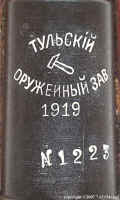 Tula Ordnance Fac(tory) 1919 |
Foremost |
Changes also took place at Izhevsk in 1919 in response to the elimination of several letters from the Russian alphabet by the Bolsheviks shortly after the revolution. These reforms had actually been proposed earlier but were not enforced until they were used to denote a break with the past. As relates to the Izhevsk barrel marks, the second to last letter in "Izhevsk" was changed and the last letter, actually a "hard sign", in "Factory" was dropped. As at Tula, the Imperial Eagle was replaced with the Soviet Crest.
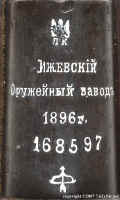 Izhevsk Ordnance Factory 1892-1919 |
Izhevsk Ordnance Factory 1919-1928 |
The Russian Soviet Federated Socialist Republic (RSFSR) was established on November 7, 1917 and in 1919 the barrel markings at Tula began to reflect this. The wording became "Foremost Tula Ordnance Factory RSFSR" and with some minor changes in font this mark was used until 1924. On January 31st, 1924 the Soviet Constitution was endorsed creating the Union of Soviet Socialist Republics (USSR) and the Tula wording was changed once again to "Foremost Tula Ordnance Factory USSR".
Foremost Tula Ordnance Factory RSFSR 1919-1924 |
Foremost Ordnance Factory (of the) USSR at Tula 1924-1928 |
In 1928 Stalin declared the first Five Year Plan which was meant to industrialize the Soviet economy and make it more self-sufficient. The barrel marks and minor parts marks were changed at both Tula and Izhevsk to reflect the changes taking place in Soviet industry. Text was eliminated completely and symbols alone were used. At Tula an arrow in a star became the standard mark and at Izhevsk an arrow in a triangle. The star had been associated with Tula in the previous marks and the arrow at Izhesvk was a reflection of the long used bow and arrow. The minor marks changed from a hammer to star at Tula and from the bow and arrow to the arrow in triangle at Izhevsk. Tula also began to use the "No" symbol above the serial number as opposed to the letter "N" prior to the serial number as on previous marks. Thanks to "gospodin" of Gunboards.com for the initial information on the relationship between the 1928 changes and the Five Year Plan.
Tula 1928-1944 |
Izhevsk 1928-1948 |
The first five-year-plan was completed early in 1932 and the second five-year-plan began in 1932 and ended in 1937. The third five-year-plan began in 1937 and at the same time Tula adopted the serial number prefixes with Izhevsk following shortly afterwards in 1938. The prefix addition was most likely part of this five-year-plan which was heavily focused on moving industrial capacity to the east in preparation for WWII. The somewhat cryptic serial number prefixes which mask the total production numbers are a natural part of this type of program.
| All content copyright © 7.62x54r.net |